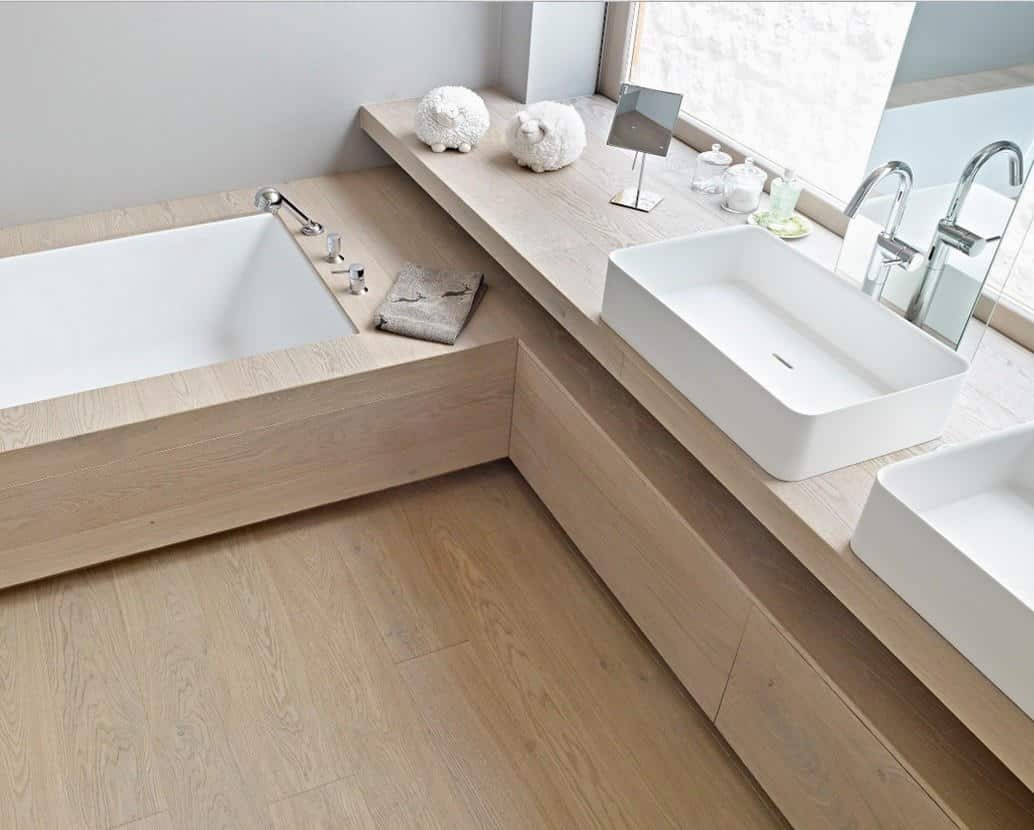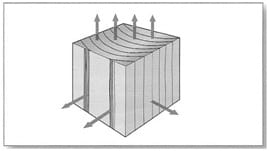Wood Flooring humidity
Wood Flooring humidity: as a water resistant parquet, against shrinkage and swelling
L’ humidity for a wood flooring it is a serious problem, because water is one of the main factors that influence its physical and mechanical characteristics; however, expressing the water content in the woody fabric as an absolute value would not give any yardstick. Therefore, it is used to quantify the water contained, by means of the percentage of humidity referred to anhydrous weight , that is to the weight of the absolutely dry wood, applying the method described in the current technical reference standard (UNI EN 13183-1).
The percentage humidity is determined by the formula:
U = P u –Po / Po x 100
where is it:
P, = weight of the wood at the time when you want to determine its humidity
Little = weight of anhydrous wood, obtainable in a ventilated stove at 103 ° C
The wood with which the parquet is made, being a hygroscopic material, tends to balance its humidity with that of the environment in which it is located; in practice the process of loss, as well as that of reabsorption of moisture (and consequently the withdrawal and the swelling of the wooden floor) never cease.When the tree is alive or just felled it can contain, depending on the wood species and the growing environment, from 50 to 300 approximately of humidity. Of this large amount of water, part is contained in the cellular lumens, part is bound to the cell walls. After killing, the water contained in the cellular lumens is the first to come out, causing weight loss, but not a decrease in volume. Only when the wood reaches humidity values around 30 does the water bound to the cell walls begin to escape. This threshold, called point of saturation of cell walls , is of fundamental importance as any further loss of moisture leads to a decrease in volume, giving rise to the phenomenon called shrinkage.
Compared to the main anatomical directions, water migrations demonstrate a greater speed in the axial direction while both radially and tangentially exchanges with the environment are much slower.
Fig. 4Water losses according to the main anatomical directions in the wood. The number of arrows is proportional to the entity
For reasons of comparison, but also of a commercial nature, the need arose to establish reference humidity values. By international convention it was agreed to assume, for countries with a temperate climate, the 12% how normal humidity of wooden parquet, taking into account the climatic factors present in these territories. In fact, this percentage corresponds to wood in perfect balance with air at 20 0 C temperature and relative humidity of 65%, average environmental values present for example in Italy. The passage of the wood from the fresh state to the state close to normal humidity (in excess or in defect) can take place by means of natural seasoning in the air or for artificial drying using special systems. In the first case longer times are required and it is practically impossible to predetermine the exact equilibrium humidity due to continuous climatic variations; in the second case, on the other hand, in addition to a higher speed (even if different according to the wood species), it is possible to dry the wood also in relation to its destination.
Generally, in parquet for outdoor use, it is sufficient to reach humidity values around 15%, while if the wooden parquet is used inside homes it is necessary to go below 12%. In the case of wooden flooring, the current technical legislation requires at the time of the first delivery a humidity of 9% ± 2% for solid elements (UNI EN 13226, UNI EN 13227, UNI EN 13228), decreasing to 7% ± 2% for multilayer elements (UNI EN 13489). Regarding the determination of humidity, as already mentioned, this can be carried out by weighing the samples before and after staying, up to constant weight, in a ventilated oven. However, there are other methods, among which the most common one concerns the use of special ones Electric hygrometers . This method, less precise than the previous one to the point that the technical standard (UNI EN 13183/2) defines it suitable for estimating, and not measuring, cannot be used when the wood is at a humidity higher than 30% or when they have been applied to wood substances such as impregnants or varnishes. Furthermore, given that each wood species responds differently, it is advisable to calibrate the instruments if they are not provided with appropriate conversion tables.
The most popular electric hygrometers can be divided into two categories: Resistance hygrometers (with nails) e dielectric hygrometers (in contact). The former use electrodes fixed in the wood and estimate the humidity in the vicinity of the same. If equipped with special insulated nails, these tools can be used to evaluate any humidity gradients, i.e. different percentages of water present in adjacent woody areas, due to both the different speed of movement depending on the anatomical directions and the practical impossibility of obtaining a constant balance with the environment (also as a function of the size of the wooden elements). The second type of electric hygrometers is based on the use of contact electrodes, which therefore do not require penetration into the material, making the estimate faster without being able to evaluate the presence of gradients.
|
Relative humidity |
0 ° |
10 ° |
20 ° |
30 ° |
40 ° |
50 ° |
60 ° |
70 ° |
80 ° |
90 ° |
|---|---|---|---|---|---|---|---|---|---|---|
|
5 |
1 |
1 |
1 |
1 |
1 |
1 |
1 |
1 |
1 |
1 |
|
10 |
3 |
3 |
3 |
2 |
2 |
2 |
2 |
2 |
1 |
1 |
|
15 |
4 |
4 |
4 |
3 |
3 |
3 |
3 |
2 |
2 |
2 |
|
20 |
5 |
5 |
5 |
4 |
4 |
4 |
3 |
3 |
3 |
2 |
|
25 |
6 |
5 |
5 |
5 |
5 |
5 |
4 |
4 |
3 |
3 |
|
30 |
6 |
6 |
6 |
6 |
6 |
5 |
5 |
4 |
4 |
3 |
|
35 |
7 |
7 |
7 |
7 |
6 |
6 |
5 |
5 |
4 |
4 |
|
40 |
8 |
8 |
8 |
7 |
7 |
7 |
6 |
6 |
5 |
4 |
|
45 |
9 |
9 |
9 |
8 |
8 |
7 |
7 |
6 |
6 |
5 |
|
50 |
10 |
10 |
9 |
9 |
9 |
8 |
7 |
7 |
6 |
6 |
|
55 |
11 |
10 |
10 |
10 |
9 |
9 |
8 |
7 |
7 |
6 |
|
60 |
12 |
11 |
11 |
11 |
10 |
10 |
9 |
8 |
7 |
7 |
|
65 |
13 |
12 |
12 |
12 |
11 |
10 |
10 |
9 |
8 |
8 |
|
70 |
14 |
14 |
13 |
13 |
12 |
11 |
11 |
10 |
9 |
8 |
|
75 |
15 |
15 |
15 |
14 |
13 |
13 |
12 |
11 |
10 |
9 |
|
80 |
17 |
17 |
16 |
16 |
15 |
14 |
14 |
13 |
12 |
11 |
|
85 |
19 |
19 |
18 |
18 |
17 |
16 |
15 |
14 |
13 |
12 |
|
90 |
22 |
22 |
21 |
20 |
19 |
18 |
17 |
16 |
15 |
14 |
|
95 |
27 |
26 |
25 |
24 |
23 |
22 |
21 |
20 |
19 |
18 |
|
100 |
33 |
32 |
31 |
30 |
29 |
28 |
27 |
26 |
25 |
24 |
|
(Moisture is expressed in% of the absolutely dry weight of the wood) |
||||||||||
Information contained in the book “The Parquet from design to installation” by EdilegnoArredo and AIPPL







